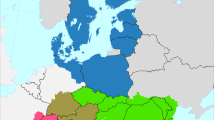Abstract
Since the introduction of the INTERREG programmes in 1990, the European Commission has closely associated border regions with the project of European Integration and especially to the accomplishment of the Single European Market. Since then, an increasing number of cross-border, interregional and transnational projects have been cofinanced by the European Union (EU) during the different INTERREG periods. However, it took until 2007 for INTERREG to be incorporated as an objective of the EU’s regional and cohesion policy, under the term: “European Territorial Cooperation ” (ETC). ETC has been associated first with a European Space Planning Policy and, since the 2000s with the objective to increase the EU’s economic position in a globalised world. Increasingly, ETC has been enlarged, intensified and become more complex, covering an ever larger territory following the EU enlargement and being associated with ever larger budgetary resources from the European Commission. Despite its obvious success, when taking into account the recent European crises, it seems essential for future ETC to build on coordination between stakeholders at all levels (local, regional, national, European) and for the European Commission to take into account not only economic criteria of wealth, but also the social and humanitarian surplus values of the programmes.
The original version of this chapter was revised: Belated corrections have been incorporated. The erratum to this chapter is available at https://doi.org/10.1007/978-3-319-74887-0_14
Access this chapter
Tax calculation will be finalised at checkout
Purchases are for personal use only
Similar content being viewed by others
Notes
- 1.
The Nomenclature of territorial units for statistics, abbreviated NUTS (from the French version Nomenclature des Unités territoriales statistiques) is a geographical nomenclature subdividing the economic territory of the European Union (EU) into regions at three different levels (NUTS 1, 2 and 3 respectively, moving from larger to smaller territorial units). Above NUTS 1, there is the ‘national’ level of the Member States. http://ec.europa.eu/eurostat/statistics-explained/index.php/Glossary: Nomenclature_of_territorial_units_for_statistics_(NUTS); 9.02.2018.
References
Beck J (1997) Netzwerke in der transnationalen Regionalpolitik. Nomos, Baden-Baden
Beck J (2011) Grenzüberschreitende Zusammenarbeit im Prozess der europäischen Integration. In: Wassenberg B, Beck J (eds) Living and researching cross-border cooperation: the European dimension, pp 129–151
Beck J, Thedieck F (eds) (2008) The European dimension of administrative culture. Nomos, Baden-Baden
Cockfield FA (1994) European Union. Creating the single market. Wiley, Chichester
Communication of the European Commission (1990) 1562/3 on the INTERREG I Initiative, 30.8.1990
Copeland P (ed) (2012) The EU’s Lisbon strategy. Evaluating success, understanding failure. Palgrave and McMillan, Basingstoke
Council of Europe (2013) Manuel on removing obstacles to cross-border cooperation. ISIG, Gorizia. http://www.espaces-transfrontaliers.org/fileadmin/user_upload/documents/Themes/Obstacles/Etude_ISIG_2013_CoE.pdf (27.11.2017)
Diop L, Lamour C (2014) L’urbanité aux frontières du Luxembourg: de la polarité industrielle à la périphérie métropolitaine. Territoire en mouvement 23(24):41–52
Drevet JF (2008) Histoire de la politique régionale européenne. Belin, Paris
Ecorys (2013) Up-date mid-term evaluation of INTERREG IV Programme. Rotterdam, at: http://www.interreg4c.eu/programme/index.html (2.11.2017)
European Commission (2017a) Boosting growth and cohesion in EU border regions, Brussel. http://ec.europa.eu/regional_policy/en/information/publications/communications/2017/boosting-growth-and-cohesion-in-eu-border-regions (2.11.2017)
European Commission (2017b) Cross border review. http://ec.europa.eu/regional_policy/fr/policy/cooperation/european-territorial/cross-border/review/ (27.11.2017)
European Commission (2017c) My region, my Europe, our future. 7th report on economic, social and territorial commission, Brussel. http://ec.europa.eu/regional_policy/en/information/publications/reports/2017/7th-report-on-economic-social-and-territorial-cohesion. pp 124–127 (27.11.2017)
Klatt M, Wassenberg B (2017) Introduction. Secondary foreign policy—local, international relations: can cross-border cooperation function as a tool to peace-building and reconciliation in border regions. Reg Fed Stud 27(3):205–218
Köhler T (2011) Die INTERREG-Programme und die Europeäische Kommission als wesentlicher Akteur der grenzüberschreitenden Zusammenarbeit. In: Beck J, Wassenberg B (eds) Living and researching cross-border cooperation: The European dimension, vol 3, pp 243–253
Lambertz K-H (ed) (2010) Die Grenzregionen als Labor und Motor kontinentaler Entwicklungen in Europa. Dike/Nomos, Zürich and Baden-Baden
Lambertz K-H (2011) L’état de la cooperation transfrontalière en Europe. In: Wassenberg B, Beck J (eds) Living and researching cross-border cooperation: the European dimension. Stuttgart, Franz Steiner, pp 59–67
Leboutte R (2008) Histoire économique et sociale de la construction européenne. Peter Lang, Brussels, pp 81–104
LRDP LTD (2003) Ex-post Evaluation of the INTERREG II Community Initiative (1994–99), December 2003 at: http://ec.europa.eu/regional_policy/sources/docgener/evaluation/inter2a/summary_en.pdf (2.11.2017)
Mestre C (1992) Les incidences de l’achèvement du Marché unique sur les régions transfrontalières. Council of Europe, Strasbourg
MOT (2017a) Cross border territories, Europe’s laboratory. Mission opérationnelle transfrontalière, Paris
MOT (2017b) Working group on innovative solutions to cross-border obstacles. http://www.espaces-transfrontaliers.org/en/activites-ue/obstacles-intergovernmental-group/ (21.11.2017)
Mozer A (1973) Entwicklungspolitik zu Hause. In: Schöndube C (ed) Entwicklungsregionen in der EWG. Ursache und Ausmaβ der wirtschaftlichen Benachteiligung. Osang Verlag, Bonn, pp 14–25
PAMINA (1998) La coopération transfrontalière dans l’espace PAMINA. Les 10 ans de la déclaration d’Intention de Wissembourg, Lauterbourg
Panteia (2010) INTERREG III Community Initiative (2000–2006), Ex-Post Evaluation (No. 2008.CE.16.0.AT.016), Final Report, May 2010
Peyrony J (2011) Cohésion territoriale et cooperation. In: Wassenberg B, Beck J (eds) Living and researching cross-border cooperation: The European dimension, vol 3. Steiner-Verlag, Stuttgart, pp 223–235
Regulation (EC) (2006) N° 1082 of the European Parliament and the Council of 5.7.2006 on the EGTC, OJ L210, 31.7.2006: 19
Reitel B, Wassenberg B, Peyrony J (2015) Territorial cooperation in Europe. A historical perspective. European Commission, Luxemburg, pp 30–42
Series of Treaty Council of Europe (1980) European outline convention on transfrontier co-operation between territorial communities or authorities, n°106, 21.5.1980
Wassenberg B (2014) L’impact du programme INTERREG sur la coopération transfrontalière dans l’espace du Rhin supérieur (1989-2008). In: Dumoulin M, Elvert J, Schirmann S (eds) Encore ces chers voisins. Steiner Verlag, Stuttgart, pp 147–165
Wassenberg B (2017) Les politiques structurelles européennes. In: Frontières F (ed) Moullé. Presses Universitaires de Bordeaux, Bordeaux, pp 245–267
Wulf-Mathis M (1997) Interview in LACE-Magazine N°1, Winter 1997/1998: 24
Author information
Authors and Affiliations
Corresponding author
Editor information
Editors and Affiliations
Rights and permissions
Copyright information
© 2018 Springer International Publishing AG, part of Springer Nature
About this chapter
Cite this chapter
Reitel, B., Wassenberg, B., Peyrony, J. (2018). The INTERREG Experience in Bridging European Territories. A 30-Year Summary. In: Medeiros, E. (eds) European Territorial Cooperation. The Urban Book Series. Springer, Cham. https://doi.org/10.1007/978-3-319-74887-0_2
Download citation
DOI: https://doi.org/10.1007/978-3-319-74887-0_2
Published:
Publisher Name: Springer, Cham
Print ISBN: 978-3-319-74886-3
Online ISBN: 978-3-319-74887-0
eBook Packages: Earth and Environmental ScienceEarth and Environmental Science (R0)




